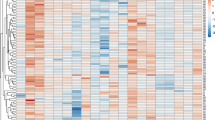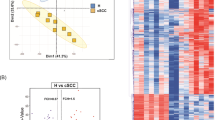Abstract
Vitiligo is characterized by the progressive disappearance of melanocytes, resulting in depigmentation. Long noncoding RNAs (lncRNAs) are a class of noncoding RNAs that play an essential role in the regulation of inflammation and immunity. Published reports on the expression profile of lncRNAs in vitiligo cases and the potential biological function of lncRNAs in vitiligo are lacking. We performed RNA-Seq to identify the functions of lncRNAs in vitiligo. In total, 32 upregulated lncRNAs and 78 downregulated lncRNAs were identified in skin lesions with vitiligo. Gene Ontology and Kyoto Encyclopedia of Genes and Genomes analysis demonstrated that mRNAs regulated by abnormally expressed lncRNAs are most relevant to melanocyte function and melanogenesis. We identified 14 aberrantly expressed lncRNAs through the co-expression pattern that regulate the melanogenesis-related genes DCT, TYR, and TYRP1. Therefore, we speculate that these hub genes may be involved in pathological mechanisms in melanocytes in vitiligo. These genes are closely related to melanogenesis in vitiligo. Abnormally expressed lncRNAs directly or indirectly act on these target genes to regulate melanogenesis. Identifying lncRNAs and clarifying the regulatory roles of the lncRNA-mRNA network may be helpful to develop novel diagnoses or treatment targets for vitiligo.
This is a preview of subscription content, access via your institution
Access options
Subscribe to this journal
Receive 12 print issues and online access
$259.00 per year
only $21.58 per issue
Buy this article
- Purchase on Springer Link
- Instant access to full article PDF
Prices may be subject to local taxes which are calculated during checkout



Similar content being viewed by others
Data availability
The datasets used or analyzed during the current study are available from the corresponding author on reasonable request.
References
Benzekri L, Hmamouchi I, Gauthier Y. Possible patterns of epidermal melanocyte disappearance in nonsegmental vitiligo: a clinicopathological study. Br J Dermatol. 2015;172:331–6.
Bellei B, Pitisci A, Ottaviani M, Ludovici M, Cota C, Luzi F, et al. Vitiligo: a possible model of degenerative diseases. PloS ONE. 2013;8:e59782.
Frisoli ML, Essien K, Harris JE. Vitiligo: mechanisms of pathogenesis and treatment. Annu Rev Immunol. 2020;38:621–48.
Jarroux J, Morillon A, Pinskaya M. History, discovery, and classification of lncRNAs. Adv Exp Med Biol. 2017;1008:1–46.
Mercer TR, Dinger ME, Mattick JS. Long non-coding RNAs: insights into functions. Nat Rev Genet. 2009;10:155–9.
Hombach S, Kretz M. Non-coding RNAs: classification, biology and functioning. Adv Exp Med Biol. 2016;937:3–17.
Li Z, Li X, Jiang C, Qian W, Tse G, Chan MTV, et al. Long non-coding RNAs in rheumatoid arthritis. Cell Prolif. 2018;51:e12404.
Abbasifard M, Kamiab Z, Bagheri-Hosseinabadi Z, Sadeghi I. The role and function of long non-coding RNAs in osteoarthritis. Exp Mol Pathol. 2020;114:104407.
Tang L, Liang Y, Xie H, Yang X, Zheng G. Long non-coding RNAs in cutaneous biology and proliferative skin diseases: advances and perspectives. Cell Prolif. 2020;53:e12698.
Li L, Xie Z, Qian X, Wang T, Jiang M, Qin J, et al. Identification of a potentially functional circRNA-miRNA-mRNA regulatory network in melanocytes for investigating pathogenesis of vitiligo. Front Genet. 2021;12:663091.
Kopp F, Mendell JT. Functional classification and experimental dissection of long noncoding RNAs. Cell. 2018;172:393–407.
Cario-Andre M, Pain C, Gauthier Y, Taieb A. The melanocytorrhagic hypothesis of vitiligo tested on pigmented, stressed, reconstructed epidermis. Pigment Cell Res. 2007;20:385–93.
Brahmbhatt HD, Gupta R, Gupta A, Rastogi S, Misri R, Mobeen A, et al. The long noncoding RNA MALAT1 suppresses miR-211 to confer protection from ultraviolet-mediated DNA damage in vitiligo epidermis by upregulating sirtuin 1. Br J Dermatol. 2021;184:1132–42.
Pei S, Chen J, Lu J, Hu S, Jiang L, Lei L, et al. The long noncoding RNA UCA1 negatively regulates melanogenesis in melanocytes. J Investig Dermatol. 2020;140:152–63.e5.
Guo J, Gan Q, Gan C, Zhang X, Ma X, Dong M. LncRNA MIR205HG regulates melanomagenesis via the miR-299-3p/VEGFA axis. Aging. 2021;13:5297–311.
Alhelf M, Rashed LA, Ragab N, Elmasry MF. Association between long noncoding RNA taurine-upregulated gene 1 and microRNA-377 in vitiligo. Int J Dermatol. 2021. Online ahead of print.
Jiang L, Huang J, Hu Y, Lei L, Ouyang Y, Long Y, et al. Identification of the ceRNA networks in alpha-MSH-induced melanogenesis of melanocytes. Aging. 2020;13:2700–26.
Zhang Y, Zhang L, Wang Y, Ding H, Xue S, Qi H, et al. MicroRNAs or long noncoding RNAs in diagnosis and prognosis of coronary artery disease. Aging Dis. 2019;10:353–66.
Zhang Y, Zhao Y, Ao X, Yu W, Zhang L, Wang Y, et al. The role of non-coding RNAs in Alzheimer’s disease: from regulated mechanism to therapeutic targets and diagnostic biomarkers. Front aging Neurosci. 2021;13:654978.
Chen W, Lin C, Gong L, Chen J, Liang Y, Zeng P, et al. Comprehensive analysis of the mRNA-lncRNA Co-expression profile and ceRNA networks patterns in chronic hepatitis B. Curr Genom. 2019;20:231–45.
Zhang Q, Ding Z, Wan L, Tong W, Mao J, Li L, et al. Comprehensive analysis of the long noncoding RNA expression profile and construction of the lncRNA-mRNA co-expression network in colorectal cancer. Cancer Biol Ther. 2020;21:157–69.
Ho H, Milenkovic T, Memisevic V, Aruri J, Przulj N, Ganesan AK. Protein interaction network topology uncovers melanogenesis regulatory network components within functional genomics datasets. BMC Syst Biol. 2010;4:84.
Yin X, Wang P, Yang T, Li G, Teng X, Huang W, et al. Identification of key modules and genes associated with breast cancer prognosis using WGCNA and ceRNA network analysis. Aging. 2020;13:2519–38.
Arora N, Siddiqui EM, Mehan S. Involvement of adenylate cyclase/cAMP/CREB and SOX9/MITF in melanogenesis to prevent vitiligo. Mol Cell Biochem. 2021;476:1401–9.
Du J, Miller AJ, Widlund HR, Horstmann MA, Ramaswamy S, Fisher DE. MLANA/MART1 and SILV/PMEL17/GP100 are transcriptionally regulated by MITF in melanocytes and melanoma. Am J Pathol. 2003;163:333–43.
Yoshizawa J, Abe Y, Oiso N, Fukai K, Hozumi Y, Nakamura T, et al. Variants in melanogenesis-related genes associate with skin cancer risk among Japanese populations. J Dermatol. 2014;41:296–302.
Bin BH, Bhin J, Yang SH, Shin M, Nam YJ, Choi DH, et al. Membrane-associated transporter protein (MATP) regulates melanosomal pH and influences tyrosinase activity. PloS ONE. 2015;10:e0129273.
Ginger RS, Askew SE, Ogborne RM, Wilson S, Ferdinando D, Dadd T, et al. SLC24A5 encodes a trans-Golgi network protein with potassium-dependent sodium-calcium exchange activity that regulates human epidermal melanogenesis. J Biol Chem. 2008;283:5486–95.
Funding
This work was supported by funding from National Natural Science Foundation of China (No. 81960562), Self-Funded Scientific Research Project of Guangxi Zhuang Autonomous Region Health Committee (No. Z20210931), and the Guangxi Natural Science Foundation (No. 2019GXNSFBA185018).
Author information
Authors and Affiliations
Contributions
LLL conceived and wrote the paper. PKC, XYJ, and LLL designed and performed the research. CXF, WGJ, QXL, LTM, and GY analyzed the data. CJL and TYH contributed essential reagents or tools. All authors read and approved the paper.
Corresponding author
Ethics declarations
Competing interests
The authors declare no competing interests.
Additional information
Publisher’s note Springer Nature remains neutral with regard to jurisdictional claims in published maps and institutional affiliations.
Rights and permissions
About this article
Cite this article
Pang, K., Xiao, Y., Li, L. et al. LncRNA-mRNA co-expression network revealing the regulatory roles of lncRNAs in melanogenesis in vitiligo. J Hum Genet 67, 247–252 (2022). https://doi.org/10.1038/s10038-021-00993-z
Received:
Revised:
Accepted:
Published:
Issue Date:
DOI: https://doi.org/10.1038/s10038-021-00993-z



